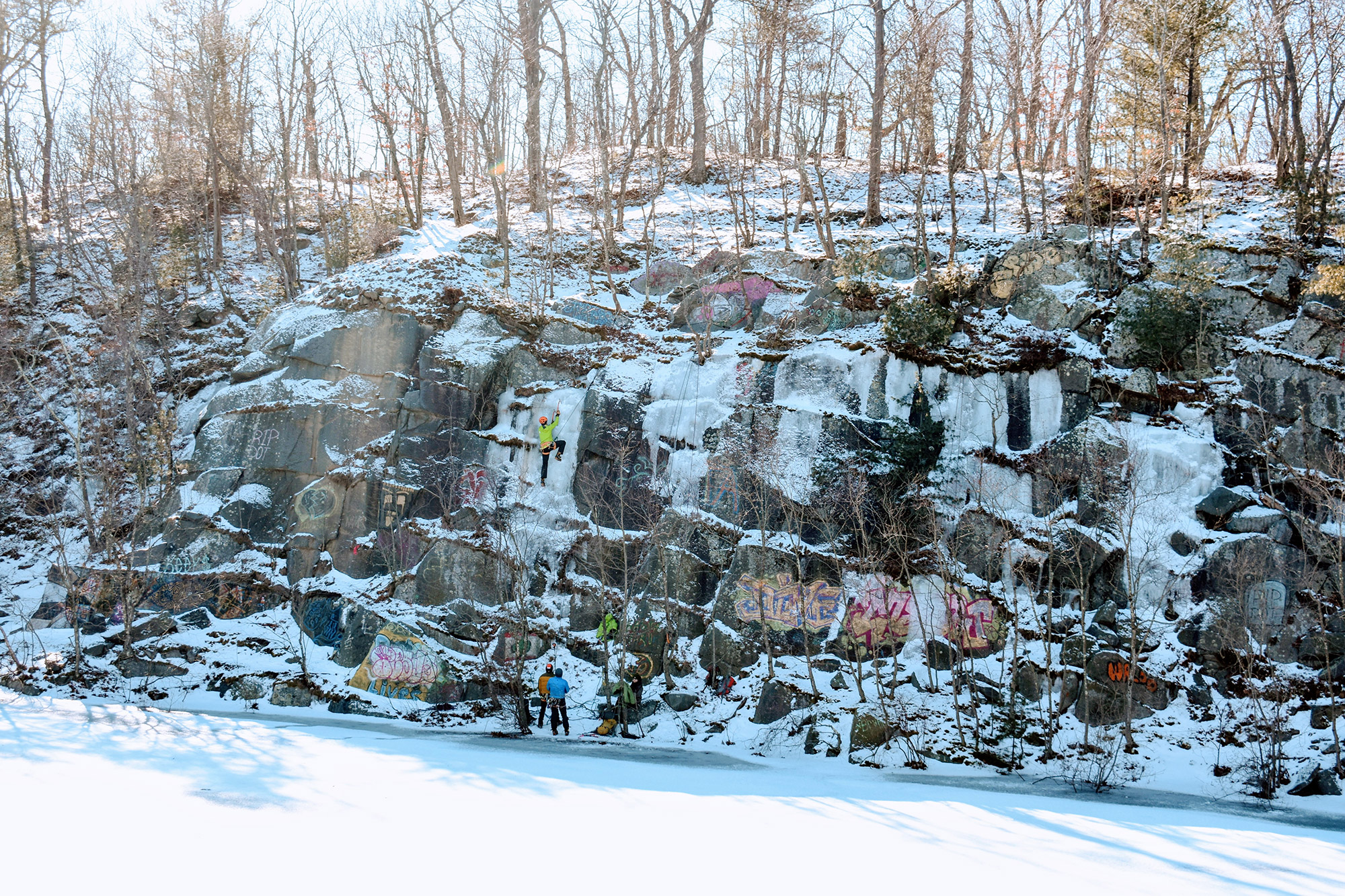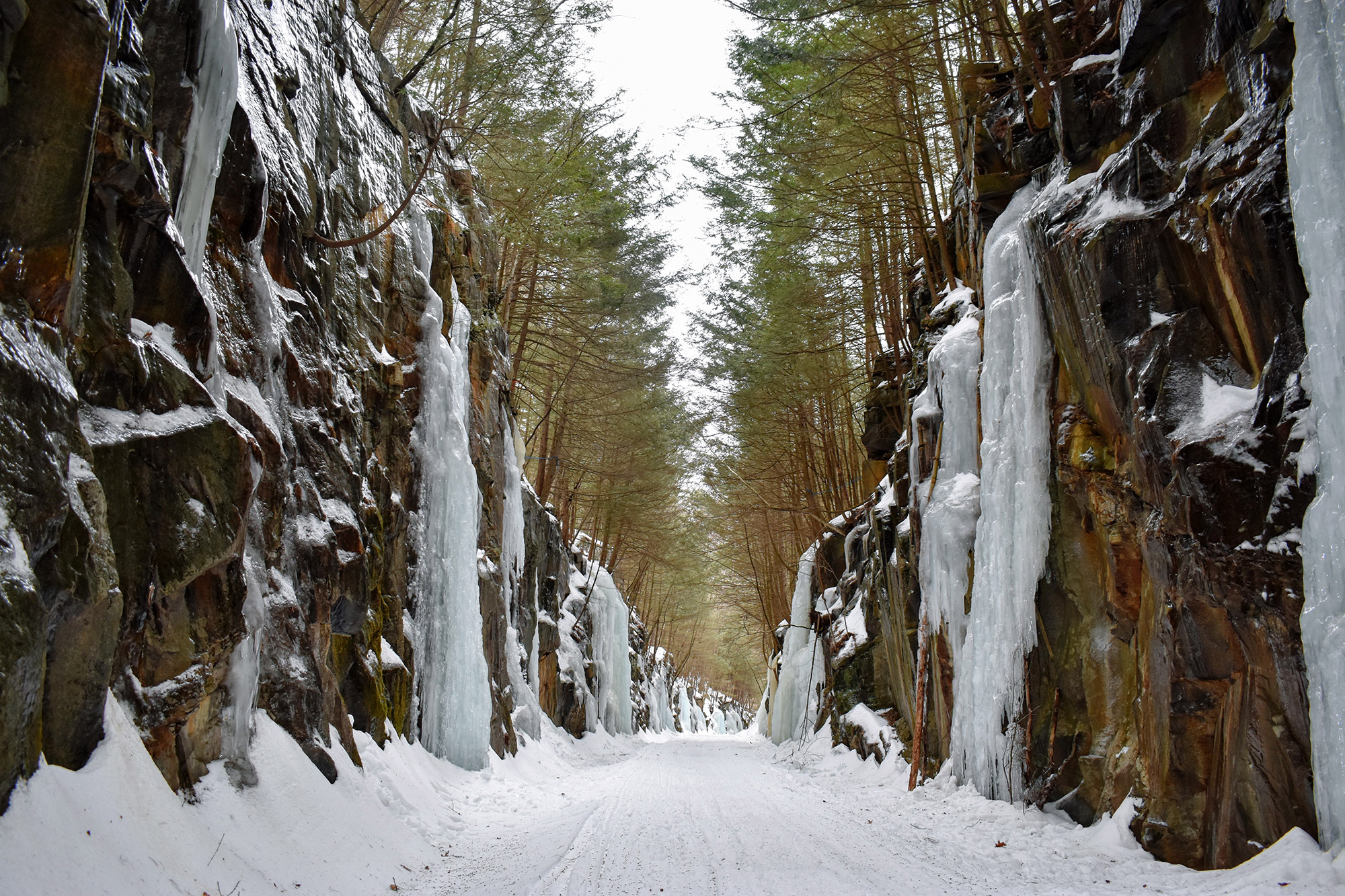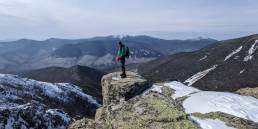Anybody who’s slipped on black ice knows that it can form in the most unexpected places. When that ice starts to freeze vertically, we, as ice climbers, typically want to climb it. How that desire manifests is sometimes quite ironic, however. In the Northeast, you’re equally likely to find climbers swinging their way up a roadside culvert, an abandoned quarry, or the walls of an old railroad cut as you are an alpine classic, like Shoestring Gully.

Auburn Ice Canyon
When most people think of ice climbing, their minds turn to frozen waterfalls, alpine cliffs, and remote gullies. What they don’t think of is shopping plazas, busy roads, and concrete, much less Worcester, Massachusetts. However, that’s where they’ll discover one of Massachusetts’ most popular ice climbing destinations: Auburn Ice Canyon.
Located at the corner of Worcester, Millbury, and Auburn—just minutes from the Mass Pike and Route 290—Auburn Ice Canyon started as a flood diversion channel for the greater Worcester area. Later, some discovered that the channel’s steep walls and melting snow above consistently icing over created steep ice climbs. Although the entrance can be seen from the busy local road, Route 20, you’ll find the best climbing and longest routes by following the culvert to its end. Here, the rock walls turn to concrete and the channel into a tunnel.
Because Auburn Ice Canyon is a drainage, its floor may consist of varying levels of water. Thus, the best time to visit is after a long-enough cold stretch, which then freezes the canyon’s floor. Popular with beginners and experts alike, Auburn Ice Canyon delivers routes steep enough for strong climbers to get a workout, and top-rope friendly attitude that newbies will appreciate. Leaders, beware: Suspect rock and interesting top-outs may make straightforward-looking climbs spicier than anticipated.

Quincy Quarries
Although most people associate Quincy Quarries with rock climbing and graffiti, you’ll also find solid ice climbing at this close-to-Boston locale. Operating as a quarry from 1825 to 1963, Quincy Quarry earned the nickname “The Birthplace of the Granite Industry,” as places and businesses across the nation used its stone. More prominently, the Bunker Hill Monument features it to some degree.
For the best ice climbing at QQ, start with “A Wall,” the first wall on the left after you make the five-minute approach from the parking lot. Depending on conditions, QQ has as many as five distinct ice flows, each providing 35-foot vertical climbs with multiple variations. The climbing itself is Scottish-like, mixing sometimes quite-thin ice with rock moves and turf sticks. This is especially true at the starts of the routes, with the best ice usually found higher up.
Of course, the ice here can be ephemeral. As a good rule of thumb, hold off on visiting until after a heavy rain or snow followed by two to three nights of colder temperatures. Although the ice usually hangs around once it comes in, it doesn’t survive every thaw. So, before you set up your top-rope, it’s a good idea to scope out A Wall from across the “Cove.” And, if the ice has unexpectedly come down, you’ll find fantastic dry tooling on Layback Corner and M Crack on M Wall (both 5.8) and on Finger Flux (5.11) in the nearby Swingle’s Quarry.
As you work your way around QQ, you’ll easily notice remnants of the historic operation. Climbers regularly use the old “staples” for anchors, and even some “feathers”—shims used to help split the granite—are still in the rock. Particularly, you’ll see one at the base of a route on A Wall. And, if history is your thing, make sure to check out the Granite Railway on the Quarry’s backside. Established in 1826, it was the country’s first railroad and is now a National Historic Civil Engineering Landmark. Find it by walking down the path between J and K walls.

Keene Railroad Cut
Keene is known as a quiet college town located on the New Hampshire-Vermont border. However, long before Keene State was founded, the city, like many in New Hampshire, was based around manufacturing. In part, the Cheshire Railroad spurred this development, carrying goods to market and outdoor enthusiasts (including Henry David Thoreau) to Mount Monadnock and the surrounding region. Although the railroad hasn’t run since the 1960s, the send train runs all winter on the Keene Railroad Cut’s walls, provided it’s cold enough.
Approaching the climbing is easy, as it’s a short walk from an obvious pullout on Route 12 near the city limits. Even better, the approach is almost always packed down, thanks to the snowmobiles that frequent the Cheshire Rail Trail. This 42-mile long trail begins near the the Massachusetts border in Fitzwilliam, New Hampshire and ends in North Walpole, New Hampshire.
You’ll know you’ve made it to the Keene Railroad Cut, or simply the Railroad Cut, when you get there. Here, the walls sharply rise above the old railroad bed, and numerous ice flows line its sides. Most routes stand between 20 and 30 feet tall, and while short in stature, they deliver steep climbing. And, convenience isn’t only found in the location and approach here. As well, sturdy trees, fixed anchors, and straightforward walk-arounds make top-roping a simple affair. Thus, it’s a popular destination for newer climbers and locals looking for a workout.
Pro Tip: Play nice with the snowmobilers, and keep your kit out of the middle of the trail. Their cooperation is key for access.
Although these three spots are not natural treasures, their local outdoor communities appreciate them for their easily accessible, close-to-home ice climbing. Have a manmade spot you’d like to share? Leave it in the comments, so we can check it out!
Tim Peck and Doug Martland
Tim and Doug met long ago at the Eastern Mountain Sports in Canton, Massachusetts. Bonding over a love of slick Quincy Quarry granite, White Mountain sufferfests, and scheming up adventures while folding tee-shirts, today Tim and Doug collaborate to write about their favorite outdoor activities and occasionally get nostalgic about tee-shirt tables.
Related Posts
April 12, 2024
Explore Like a Local: The Outdoor Mecca of North Conway, NH
There's a lot to love about this New…
April 3, 2024
5 Things To Do in the Boston Area During Mud Season
Adventure opportunities are abundant…




